Plastic surgery is the most common type of service provided by plastic surgeons. Many people always regard small defects in their noses as tragedy. But it may be difficult to decide on surgery-rhinoplasty. Modern aesthetic medicine provides an innovative way to eliminate defects. In the presence of minor defects, non-surgical rhinoplasty can improve the appearance and make the face symmetrical.
Types of rhinoplasty
In plastic surgery, it is customary to distinguish between several types of rhinoplasty based on the surgical technique and goals.
All types of operations are divided into primary and secondary (repetitive), they can be:
- Reconstructive. This group includes procedures aimed at restoring anatomical disorders due to improper intrauterine growth or due to trauma or disease.
- Aesthetic. Designed to correct defects.
According to the problem to be solved, there are many types of rhinoplasty:
- cut back. Provides to reduce the size of the bone cartilage frame of the nose. This may be the shortening of the tip, the narrowing of the bridge of the nose, the width of the nostril and the lateral cartilage.
- Enhanced. The aim is to correct the defect by increasing the size of the bridge of the nose. It can also be used for secondary plastics.
- Rhinoplasty. Eliminate the curvature of the nasal septum to facilitate nasal breathing, including solving the problem of snoring.
- grafting. The desired shape of the nose is made from the cartilage tissue of the patient. For transplantation, the cartilage tissue of the auricle and nasal septum can be taken.
- Reconstructive rhinoplasty. Aims to correct the results of previous operations.
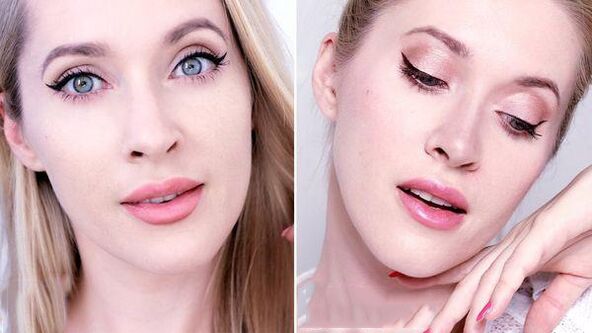
The purpose of the intervention may also be a separate hypertrophic columella (the bridge between the nostrils). Changing the shape of the tip of the nose (eliminating hooks or upturns) is a single and most difficult type of surgery.
For any correction, the surgeon can choose surgical or non-surgical interventions.
Operating room
It is performed under general anesthesia. The entire operation process can take up to several hours, and the results can be maintained for many years. Before the operation, the patient must sign the operation consent form. Therefore, it is necessary to carefully weigh the pros and cons and strictly abide by the pre-operative preparation rules, including:
- Perform blood tests, fluoroscopy, and electrocardiogram;
- Consult other professional doctors (dermatologists, therapists, psychiatrists);
- Stick to your diet.
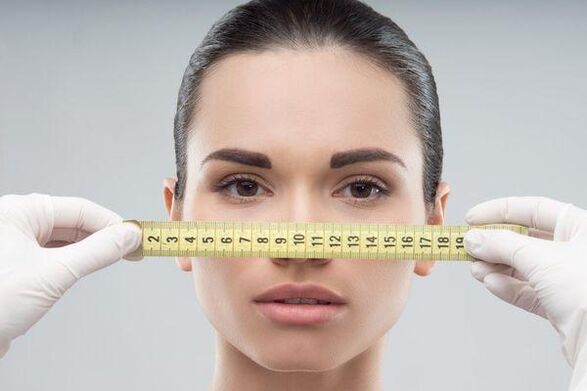
After the operation, the patient was hospitalized for several days under the supervision of medical staff. After you leave the hospital, you should strictly abide by some rules and restrictions.
Like any surgery, nose repair surgery has many contraindications and may cause side effects and complications.
Non-surgical
Or, use plastic that does not require surgery. Contour plastic is minimally invasive and does not involve surgical intervention. It can correct asymmetry, slightly reduce the tip, eliminate humps, and straighten the nose, but it is not suitable for solving complex problems (recovering respiratory function, eliminating congenital defects).
Different from the classic rhinoplasty:
- No complicated surgery and long-term rehabilitation;
- Progress speed
- Short duration (not more than one year);
- As a result, the possibility of re-execution is lost.
This can be injectable plastics that use fillers, hyaluronic acid gels, hormone-disintegrating drugs, or use sutures or splints for non-injection correction.
Artificial rhinoplasty is several thousand rubles cheaper than traditional rhinoplasty.
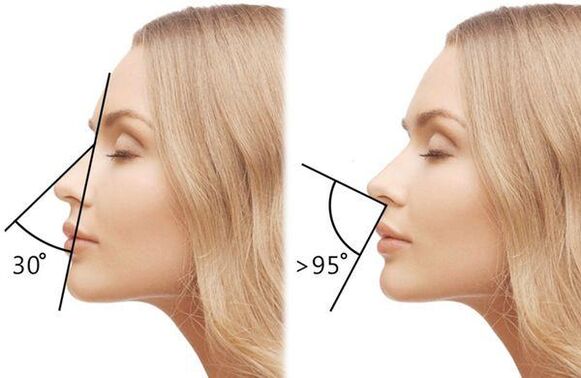
Rhinoplasty surgery classification
A complete rhinoplasty does not involve interventions to correct the entire nose. This is the most popular type of surgery. Conditionally divide the surgical indications into two types. According to these indications, the following operations will be performed:
Cosmetic plastic. If you want to eliminate the following nose defects:
- Dorsal bulge (hump);
- Length is too long
- Thick nose (potato);
- Saddle back
- Large nostrils.
Functional plastic. Designed to eliminate defects that cause poor breathing and interfere with the passage of air through the nose:
- Bent injured diaphragm
- Narrowing the nostrils (birth defects)
- Congenital cartilage tissue defect.
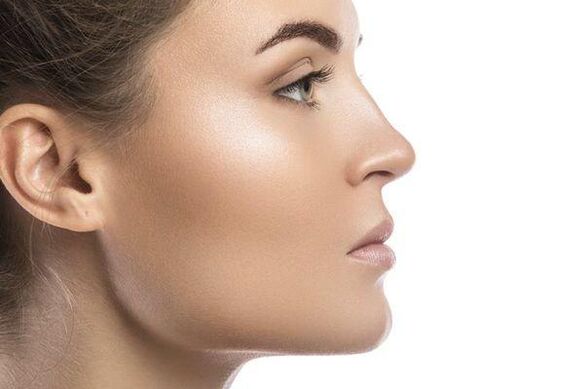
turn on
Use this technique when the assigned task cannot be completed in a closed manner. Make incisions along the small intestine (the folds of skin between the nostrils) and the alar where they connect to the lips. Open rhinoplasty allows you to lift up the soft tissue and cartilage to gain access to the internal area for manipulation. Technically complex and large-scale operations require:
- Severe deformity of the nose, including lateral displacement;
- A combination of deformity and deformity of the nose ("cleft lip" or hard paw);
- Reconstruction, in which grafts were used.
The disadvantages of this intervention include damage to the small bowel artery, postoperative scar formation and long-term postoperative tissue edema.
Rhinoplasty is only performed in an open manner. Correcting the defects of the original plastic is an arduous task, and therefore, there is always no guarantee of a perfect aesthetic effect.
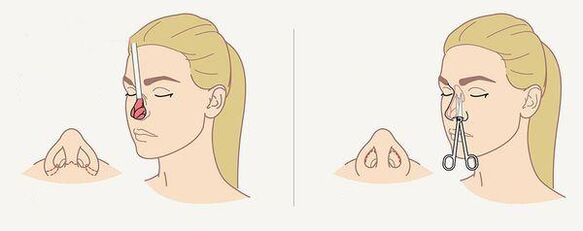
shut down
This method is less traumatic than the open method. The incision is made from the inside on the mucosa of the vestibule of the nose. This type of access is performed when a small batch operation is to be performed. This type of intervention is divided into edges (along the inner surface of the wing of the nose), transseptum, intercartilage and transcartilage. The closed option is to use micro-instruments for endoscopic rhinoplasty.
Damage to arteries and tissue dystrophy can be ruled out, and postoperative scars are invisible because they are located in the nasal cavity, so the outside of the skin is not affected. This method is usually used for aesthetic operations.
laser
Surgery in which a laser is used instead of a scalpel to cut tissue. The laser incision is smoother because the parallel blood vessel cauterization excludes the occurrence of bleeding.
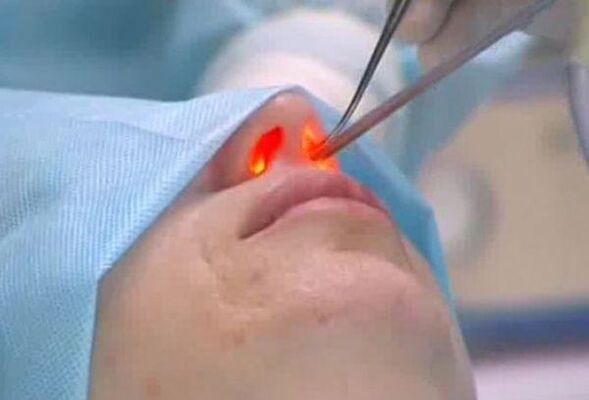
There are 2 types of laser rhinoplasty:
- Open, which involves dissecting the tissue before modeling the soft part or cartilage base;
- Superficial-No skin incision is made, but the superficial layer is evaporated to correct subtle changes in the nose tissue.
Injection reconstruction rhinoplasty
Sometimes, those who decide to undergo rhinoplasty not only have to predict and develop a model, but also look at the final result. This can be helped by the contour injection nose shaping process. The result is faster, more comfortable, and cheaper.
You can inject the medicine repeatedly. In some cases, fibrous tissue will form at the injection site and the nose will be deformed for a long time.
Hyaluronic acid injection
The effect of the injection of hyaluronic acid lasts for about six months. The introduction of the drug allows you to level the skin surface and make the nose symmetrical, and fill in small irregularities. Fillers based on hyaluronic acid are used in cosmetic surgery. These funds are classified as biodegradable, that is, soluble. Over time, the medicine will decompose into safe ingredients-water and carbon dioxide.
Plastic nasal filler
There are several sets of fillers. In addition to the above-mentioned biodegradable, it also includes:
- Based on animal collagen;
- Collagen derived from humans;
- On calcium hydroxyapatite;
- On synthetic lactic acid.
These fillers can have a long-lasting effect.
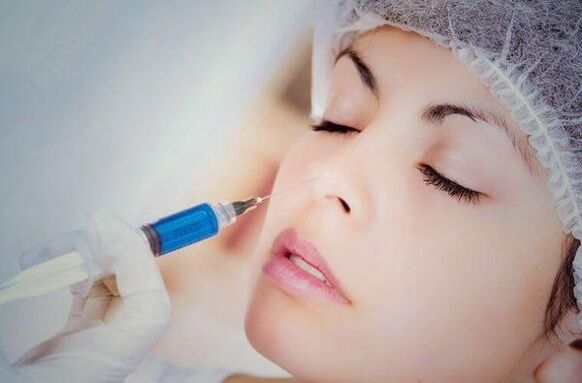
Biodegradable (non-absorbable or permanent) fillers are based on silicone or other synthetic bases (biopolymers). The effect will last for a long time after application, but experts advise against using them. There are many reasons for rejecting synthetic fillers:
- They can cause tissue fibrosis;
- It is impossible to remove them from the body;
- It may become an obstacle to rhinoplasty surgery in the future.
Hormonal drugs
To correct certain defects in the nose, glucocorticoids-a synthetic substance similar to the hormone produced by human adrenal cortex hormones are used. They can soften and partially dissolve the cartilage tissue, thereby correcting the shape of the wings and nose tip, and smoothing the hump.

The process is relatively simple, but difficult to prepare: the dose and depth of the drug must be calculated very accurately to avoid asymmetry and unnecessary cavity formation in the nose. In addition, too much hormone can trigger uncontrolled tissue atrophy.
Usually, this correction is carried out in the course of several processes.
Library Science
Lipolytic agents are agents used for mesoscopic injection. It is a biologically active substance that can promote the burning of subcutaneous fat. Dermaheal is used to correct the shape of the nose. It helps to remove wrinkles and wrinkles and will get rid of the "smelly" nose. Contains active ingredients: phosphatidylcholine, hyaluronic acid, carotene, etc.
No injection for rhinoplasty
There are far fewer cases where injections are not required for nose correction. Experts believe that such a procedure is not effective enough.
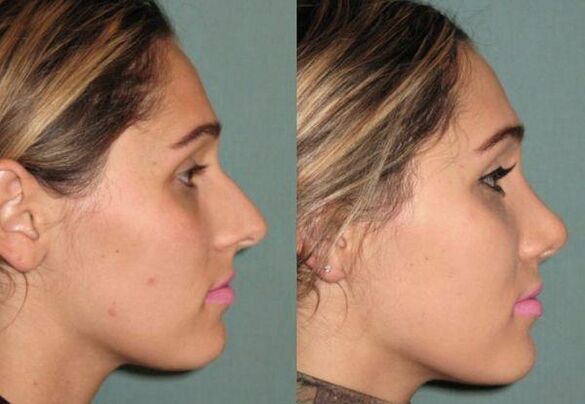
Clip-on tongue
To align the back of the nose and its tip, use a splint-a device made of plastic or plaster. This design creates constant pressure on cartilage and soft tissues and changes their position over time. With the help of a splint, you can lift the tip, narrow the wing, reduce the length (by raising the tip), smooth the hump and restore symmetry.
Nowadays, lightweight movable structures in the form of clips or clips are becoming popular. They need to wear it every day for several months.
Threads
In order to eliminate asymmetry, straighten the back, correct the wings and the tip of the nose, use filament rhinoplasty. The correction technique consists in inserting a strong self-absorbable thread under the skin. Unlike fillers, the nose does not expand visually after the thread is inserted. The results lasted for 3 years.
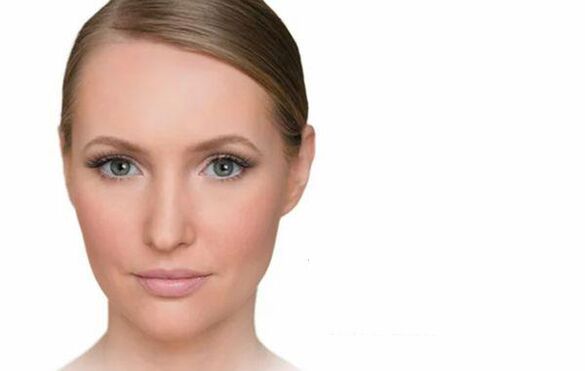
The bionic thread is made of caprolactone and fixes the tissues in the nasal cavity area through multiple grooves. The thread is inserted through a fine puncture, and then the beautician tightens it and provides the desired shape to the nose area. The results become apparent after 2-3 days. Other benefits of using threads:
- Low invasiveness
- Painless
- Use local anesthesia;
- No complications;
- There is no swelling or bruising.
Disadvantages of this correction method:
- Scars may appear at the puncture site;
- The thread can be contoured and can be seen.
This procedure is not suitable for people with fair and weak skin and people who are prone to scarring.
Program instructions
When the shape and size of the patient’s nose are met, the doctor is likely to prescribe a procedure for him without performing an operation. In order to eliminate the following problems, you can correct the following without a scalpel:
- From the asymmetry of the nose;
- Depressions, depressions, depressions and irregularities;
- Drooping from the nose
- From the hump;
- From a flat back
- Loose skin near the nose.

This procedure can also be used as a temporary measure if minors with severe disabilities (due to fractures or injuries) cannot undergo surgery.
Among men
People tend to adopt radical methods to use fillers for modeling to completely eliminate defects. The indications for male rhinoplasty may be:
- Frequent sinusitis, chronic nasal congestion;
- Injuries that cause deformation of the nose and its nasal septum;
- Congenital lesions and deformities of the skeletal structure of organs;
- Saddle-shaped, with large nostrils, wide bridge of the nose, long or thick nose;
- Breathing disorder
- The existence of the ugly hump.

Among women
Any type of intervention can be applied to women. The surgeon decides which one to choose. If you want to make minor changes, you can solve the aesthetic problem without using a scalpel. The injection method is usually used on the eve of the operation so that the woman can assess how her nose will look in the future.
Problems that can be solved using this procedure
Hump correction
The reduction is achieved by injecting filler into the curved part. To correct the hump, inject the gel along the entire length of the back of the nose. In most cases, absorbable hyaluronic acid preparations can be used to straighten the nose.
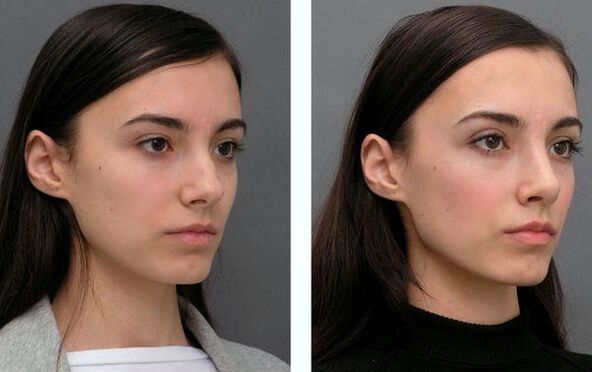
Tip correction
It is performed by injecting filler into the problem area. This kind of rhinoplasty is especially needed when there are small pits or depressions on the tip of the nose. The potato's nose is corrected by inserting a filler at the tip, which makes it sharper.
The tip can be raised by injecting gel into the columella area of the nose. Visually, this hides the hooked tip. In some cases, it is also necessary to inject into the nose to shrink the nostril slightly.
Repair broken nose
If the nose is injured more than once, contouring will not help. In this case, only surgery on the nasal septum is indicated. And most likely to carry out comprehensive reconstruction and aesthetic operations. Both the septum and the osteochondral external skeleton may need to be reconstructed.
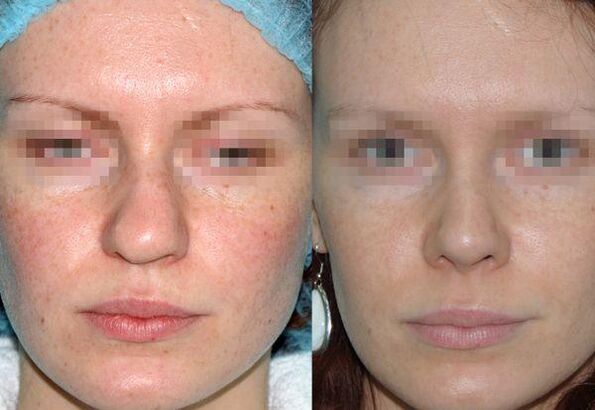
Backrest alignment
It is impossible to align the curved bridge of the nose without surgery. Rhinoplasty injections can only cover up the defect. For example, the nose bridge is corrected by injecting fillers on the entire surface of the nose bridge to the extreme tip (the nose bridge is low and the tip is raised).
Reduce the wing
Hyaluronic acid gel is used to correct the asymmetry of the nose. In this case, the expert must accurately calculate the dose.
After rhinoplasty with hormones, the nose becomes thinner and more expressive.
If you need to remove the asymmetry of the nostril or reduce the asymmetry of the nostril, inject the filler into the lower part of the nose.
How old is the operation
There must be a clear reason for surgery on the face. If it is based on a whim of a girl or boy, a conscientious plastic surgeon will not correct the minor’s nose.

Persons over 18 years old are allowed to undergo surgery. In rare cases, this condition may be violated. The minimum age for rhinoplasty for girls is 13-14 years old, and for boys 15-16 years old.
For medical reasons, teenagers can receive almost any plastic surgery. However, the doctor recommends that you wait patiently for age until at least 80-90% of the organs are formed.
How to prepare for non-surgical procedures
Compared with classic surgery, it is easier to prepare for non-surgical procedures. Perhaps your doctor will suggest that you consult a dermatologist and tell you what tests have been done to determine the contraindications and contraindications.
Following the following rules will help reduce the risk of complications:
- 10 days before the plastic surgery, you need to stop drinking alcohol;
- Salicylate increases bleeding, which means you should stop taking "aspirin" and other similar drugs one week before the operation;
- Do not eat at least 10 hours in advance;
- A few days before plastic injection, it is recommended to exclude high physical activity;
- Since you cannot bend over to wet your face after the operation, you must wash your hair the day before.

The doctor prescribes antihistamines. Due to increased temperature, menstruation, and respiratory diseases, the procedure must be abandoned until recovery.
Do i need anesthesia
Non-surgical rhinoplasty does not require general anesthesia. For anesthesia, use local application or infiltration anesthesia.
Implementation technology
Non-surgical plastic surgery is performed in an outpatient clinic and does not require hospitalization. After the operation, the client of the plastic surgeon went home.
Initially, the future shape of the nose was thoroughly checked and computer modeled. The average operating time is 35-60 minutes. The operation is carried out as follows:
- The patient is conscious and only uses local anesthesia. The doctor applied lidocaine cream to the nose and around. The exposure time under film is 10-15 minutes.
- After opening the ampoule with the medicine and filling the gel into the micro cannula, the filler is gradually injected into the designated area of the nose. If the client has a need, he can observe the progress of the process with the help of a mirror, which will be borne by him.
- If necessary, the beautician can refill the filler.
- The final stage is a light manual massage. In order to better distribute the filler, this is necessary.
The results can be evaluated immediately. The filling is safe and can be completely absorbed within 1. 5 years.
Consequences and contraindications of non-surgical rhinoplasty
Women should not be corrected during pregnancy or menstruation. Non-surgical correction is prohibited for people with the following diseases:
- Acute infectious disease;
- Keloid
- Autoimmune disease
- Pathology of the endocrine system, including diabetes;
- Hemophilia and other blood clotting problems;
- Allergies and personal intolerance to the ingredients of the medicines used;
- Oncological disease, any localization of the tumor.
What complications will occur
Complications after surgery occur in 10% of cases. They may also occur during surgery (bleeding, skin rupture, mucochondral flap tear, violation of the integrity of the bone pyramid, bone site fracture).
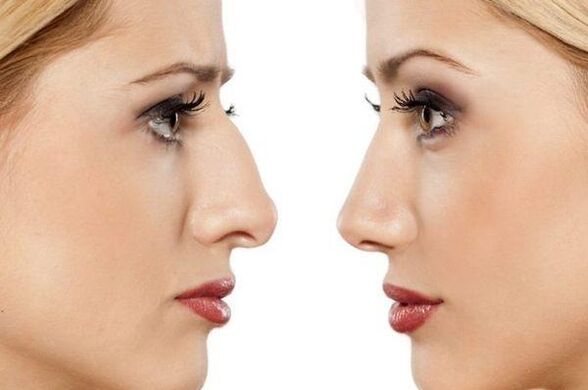
If some appearance defects are eliminated during the operation, many complications may result:
- Nosebleeds;
- Postoperative pigmentation;
- Bone call
- Soft tissue swelling and hematoma;
- Smell disappeared
- The appearance of keloid scars;
- Difficulty breathing;
- The nasal septum is curved.
Although rhinoplasty is considered a difficult operation in cosmetic surgery, it is not that dangerous to perform rhinoplasty without surgery. After that, a special splint is applied to the patient's nose to fix the result and protect it from injury.
A few hours after the operation, the skin of the nose may become red and swollen. These problems will disappear completely within 24 hours. After tightening with threads, bruises may form, and these injuries will disappear completely within a week.
Rare complications include procedures that occur because the surgeon is inexperienced or may not be able to follow postoperative rules: displacement of the filler and breakage of the thread inserted under the skin. The doctor should deal with the problem urgently.
Take care of your nose after surgery
Laser rhinoplasty, hyaluronic acid injections and fillers can minimize the recovery time. You can go home immediately after the nose shaping procedure is completed. The swelling subsided within 1-2 days.
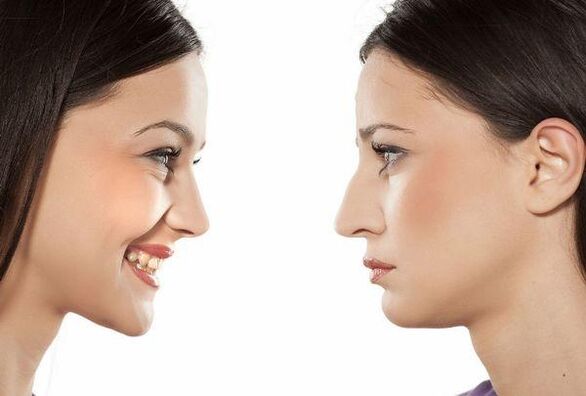
On average, rehabilitation can last up to a few days (depending on the correction method performed). There are almost no restrictions after performing the operation. You can continue to work, participate in sports and live a normal life.
During the postoperative period, it is necessary to monitor facial expressions: not squint, frowning. Within a few hours, you should not strain your muscles, blow your nose, sneeze and cough. You should not wear glasses for the first 2-3 days of recovery.
Strict restrictions apply to visiting any swimming place (pond, swimming pool, bathroom, sauna). You also need to give up sunbathing, smoking and foundation.
You cannot massage the injection site or undergo 2 weeks of physical therapy.
How long does the edema last after surgery?
The entire recovery period after surgery may take about a year. In the first few days, the patient must wear a bandage, bandage or plaster cast. Facial swelling will subside within 1-2 days. After 21 days, the plaster cast was removed, and the blood clots on the nose and tampons were removed.
In the next 3 months there will be a positive recovery and the signs of side effects will subside, but slight changes will not occur until the end of this year.
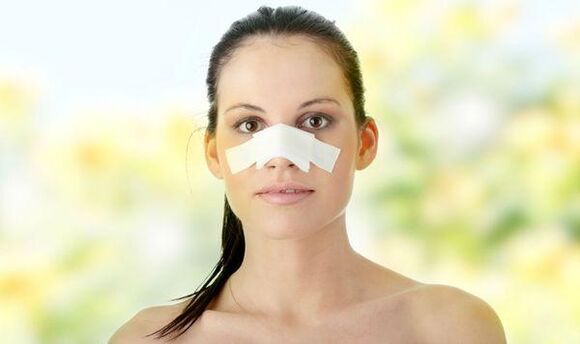
What to do if the operation fails
Only after 6 months can the results of the operations performed be judged. Practice has shown that only 20% of all interventions to correct or eliminate nose defects are not the only interventions.
If the nose does not reach the desired shape or the swelling still exists after this time, the operation can be considered unsuccessful. In this case, duplicate operations will be assigned.
When to repeat the procedure
The effect of non-surgical nose surgery lasts about one year on average. You can repeat the process at any time.
After the operation, a repeat (secondary) rhinoplasty can be performed no later than one year later. Technically, this is a more complicated process. If the patient is not satisfied with the results or the previous operation was unsuccessful (not achieving the expected results), a prescription should be given.
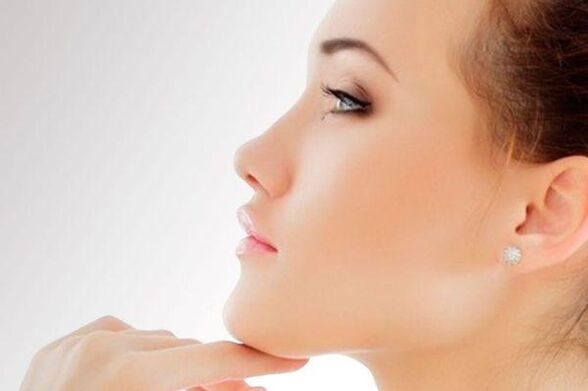
Benefits of non-surgical rhinoplasty
The filling and suture procedure cannot be considered as a complete alternative to surgery, but it has many obvious advantages. The main ones are:
- Painless
- Short recovery period (sometimes not);
- Achieve results quickly;
- Reversibility (if the result is not satisfactory, you can always return to the previous table).
There are pros and cons to this procedure. It has a very low impact on the general condition of the body, will not harm the facial tissues, and will not form scars and scars thereafter. However, if the injection is not correct, a gel mass may form under the skin. Their displacement will cause a change in the shape of the nose.
After minimally invasive intervention, without sutures, the skin healed better. But the risk of infection and infection still exists.
The low cost makes the program available to everyone who wants to improve the appearance. However, possible complications force us to be very careful about the choice of clinics.The most common is to perform cosmetic interventions after non-professional salons and doctors without proper qualifications.The final decision can only be made after studying the owner’s previous work and the clinic’s assessment.




















